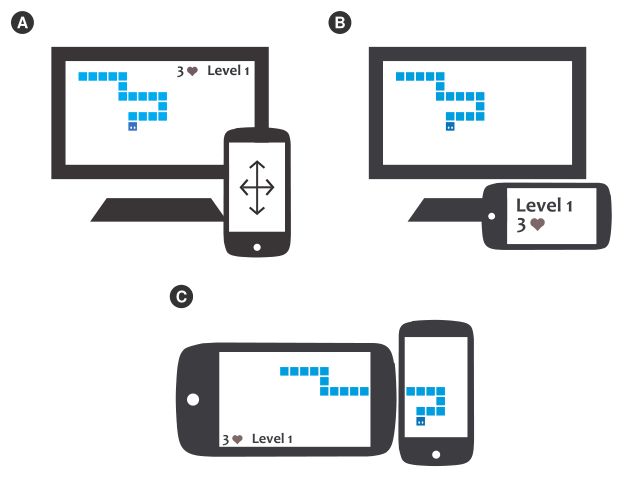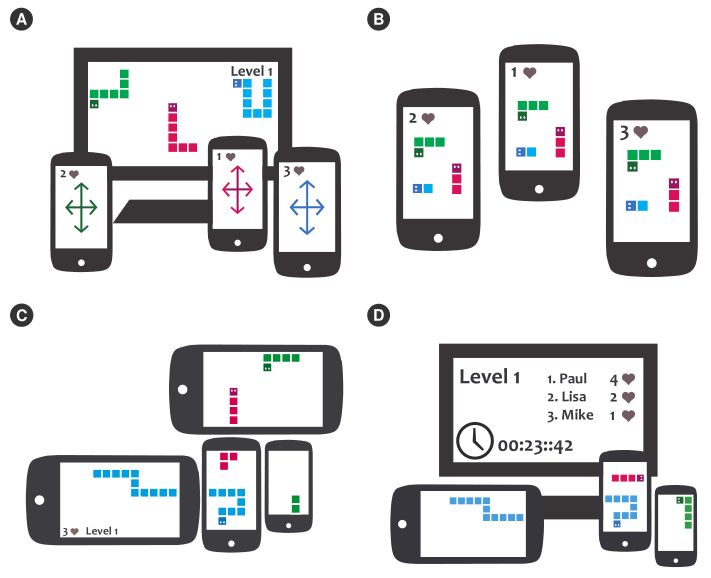Many game companies selling gaming devices like Nintendo, Microsoft or Sony like to sell multi-screen games as the best thing since sliced bread. They advertise innovative game modes only possible with multiple devices or screens. Of course the Wii U with its gamepad is a nice example:
while a 6.2″ touch screen and intuitive motion controls create innovative ways to play that are only possible on Wii U
nintendo.co.uk
So let’s take a look at these innovative ways to play.
Single player
Multi-screen single player games are restricted by the number of the available devices most of the time. There may be one or two desktop computer, smart TVs or gaming consoles with a bigger screen and one ore two smartphones or tablets with a smaller screen. This leads to three major game modes:

First of all you could use one mobile device as a game controller (A) and the bigger screen as your playing field. Google is using this setup for most of their chrome experiments like Super Sync Sports and Roll It and Nintendos Wii U controller is perfect for this setting. You can use all the neat mobile capabilities like motion sensor, camera, microphone, locale speakers and sensors without being limited by small screen size or low CPU power. This is a nice extension to “normal” games and tends to bring back this “Wii feeling” of new, somewhat tangible user interfaces.
The second game mode (B) uses one screen for the actual gaming and the other one for additional statistics like the current level, high score, number of lives, coins, power ups, etc. This is a common pattern for companies trying to sell multi-screen games, because extending existing games with this additional screen generally is not as much work as designing a multi-screen only game from the ground up. There may exist very sophisticated examples for this “second screen” pattern but it is too easy for designers and developers to do it poorly.
The last game mode (C) treats every device equally as input and output device. This may lead to very interesting game concepts like playing fields consisting of several screens (like Googles Racer) or games that make use of the devices orientation and position towards each other.
Of course there may exist much more game modes for single player multi-screen games. Depending on the games complexity it may use multiple of these concepts at once or alternating.
Multi player
This is where the fun begins. Multi player games in general involve a lot of shouting, plotting evil plans against each other and having fun while communication fails badly – at least most of the time. This is especially the case when all players are located in the same room and the game is playing with this group dynamic and communication thing. A very good example for this board game like group fun is Spaceteam. This game even sells “Teamwork”, “Shouting” and “Confusion” as features.
 The first multi player game mode (A) looks like the single player one – one big screen displays the playing field and the other smaller devices are used as input devices. Of course this is much more fun with multiple players. I actually tried this game mode with a very, very simple snake clone (every player has his own snake) and swipe navigation on the mobile devices. It turned out that even this simplest of all games was fun to play without any gimmicks. Polishing the game aiming to a nice multi-screen and multi player experience could result in an addictive party game.
The first multi player game mode (A) looks like the single player one – one big screen displays the playing field and the other smaller devices are used as input devices. Of course this is much more fun with multiple players. I actually tried this game mode with a very, very simple snake clone (every player has his own snake) and swipe navigation on the mobile devices. It turned out that even this simplest of all games was fun to play without any gimmicks. Polishing the game aiming to a nice multi-screen and multi player experience could result in an addictive party game.
There is always the possibility to mirror the playing field to every device (B). That doesn’t make much sense for one player and one could argue if it does for multiple players. I wouldn’t describe this mode strictly as multi-screen but added it here for the sake of completeness.
The big screen mode (C) works like described in the single player scenario. With every player using one device this mode promises a lot of nice game concepts. In case of the illustrated snake game it could be part of the games concept to let the players find out how their devices are arranged into a bigger screen by watching the snakes positions and movements carefully. Arranging the devices could be a gameplay element on its own and could be triggered once per level or by certain enemies or add ons. This game mode requires the players to cooperate and communicate a lot which leads to some of the group fun described above.
The last game mode (D) uses the bigger screen to display game stats like a high score, level, time, etc. while the actual game takes place on the smaller devices. A game using this setting could also use the concept of a public screen and many private screens. This corresponds to many card and board games that make use of private information like the players hands of cards or the available letters when playing Scrabble.
Of course you can combine these games modes too. Also, they don’t differ between cooperative and competitive gameplay: Do the players have to work together to reach their goal like in Spaceteam or do they compete with each other like in Googles Super Sync Sports? By introducing teams you could have both. In the case of snake for example there could exist a four player mode where teams of two players each control their own snake. Inside their team the players have to cooperate for example by one player adjusting the speed the other one the direction of the snake. But in a whole the two teams compete because every team wants to keep “their” snake alive as long as possible.
Conclusion
This was a brief overview over some possible game modes for multi-screen games. I think it is essential that adding a screen to your game should also add some value to your game. It seems to me that some game companies tend to forget that, using the phrase “multi-screen” merely as a marketing instrument. On the other hand there really exist a lot of nice game concepts that wouldn’t be possible with only one device and one screen, so go out there and make use of them!







